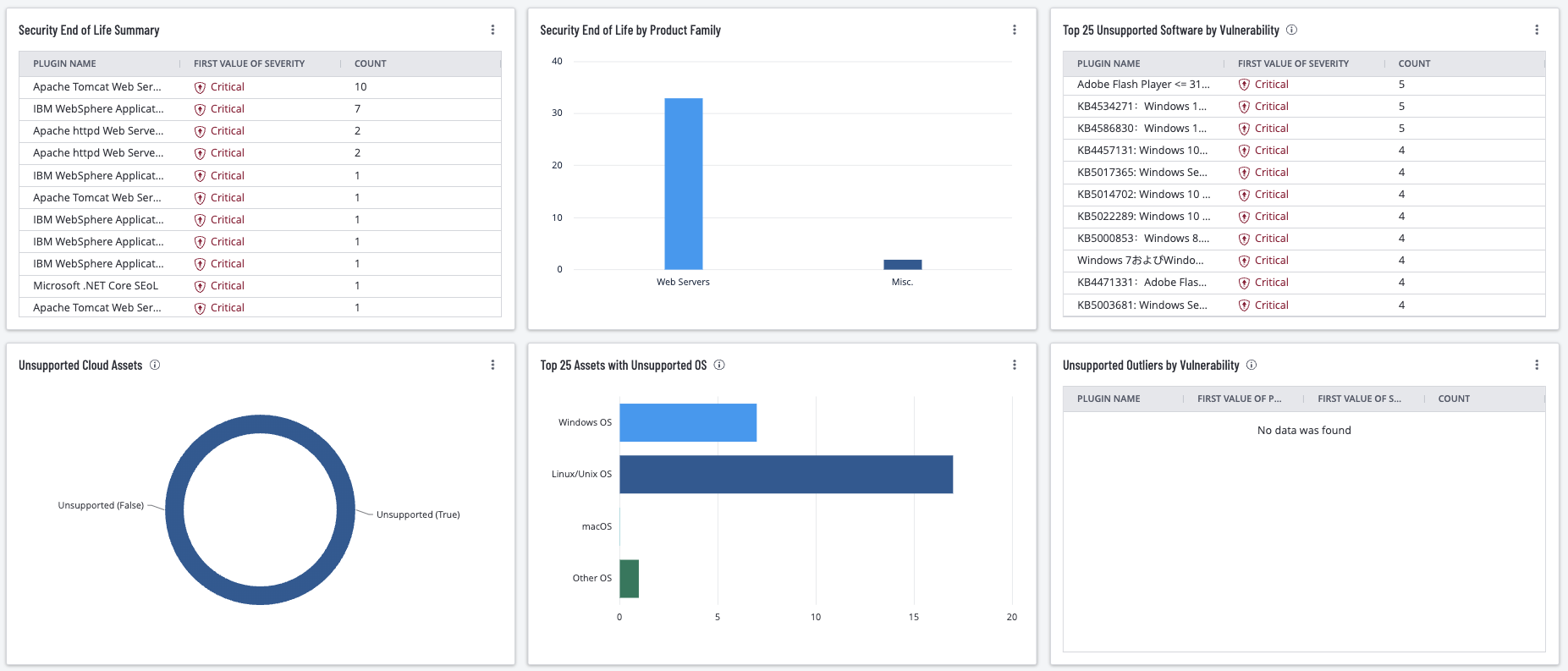by Carole Fennelly
November 8, 2022

The proliferation of unsupported and end-of-life (EOL) products is a common security problem experienced across all organizations. As applications and operating systems reach EOL, vendors stop offering support, causing security and stability to decrease over time. This dashboard provides organizations with a clear and simplified method to identify EOL software and enables security managers to predict where risk will increase to develop a mitigation plan.
Identifying assets running EOL applications is an important part of assessing and minimizing organizational risk since patches, updates and security fixes are longer available. The Center for Internet Security (CIS) Critical Controls (Sub-control 2.2) states that organizations must ensure that only software applications or operating systems that are currently supported and receiving vendor updates are added to the organization’s authorized software inventory. Organizations need to tag all unsupported software in the asset inventory.
Tenable.io enables organizations to continuously assess the health and security posture of the network, including identification and monitoring of unsupported software. Quick identification of unsupported operating systems and applications, enables risk managers to see risks associated with EOL software. Identifying exposures, provides the operations teams direction to implement, act, and prioritize remediation efforts to mitigate cyber risk. Risk managers and operations teams can communicate to the leadership team how upgrading unsupported operating systems and applications reduces their network risk.
Tenable.io uses active methods to identify EOL products found in the environment by examining the Microsoft registry, common software installation locations, or using applications utilities such as YUM or APT in Linux systems. Risk managers are able to verify the operation teams activities and identity areas for risk mitigation.
This dashboard provides the organization with a clear and simplified method to identify EOL software and enables security managers to predict where risk will increase and develop a mitigation plan.
Security leaders need to SEE everything, PREDICT what matters most and ACT to address cyber risk and effectively align cybersecurity initiatives with business objectives. Tenable.io discovers and analyzes assets continuously to provide an accurate and unified view of an organization’s security posture. The requirements for this dashboard are: The requirements for this dashboard are: Tenable.io Vulnerability Management (Nessus, NNM) and Tenable.cs.
Widgets
Top 25 Unsupported Software by Vulnerability: This widget displays the top 25 vulnerabilities, filtered by CVSSv3 score greater than 9.0, and VPR score greater than 9.0. Results are sorted by count. As applications reach their end-of-life (EOL), vendors stop offering support. While patches and updates are released for new versions of software, unsupported versions are left out. Without receiving a patch, EOL applications remain vulnerable to zero-day vulnerabilities, decreasing their security and stability. Identifying unsupported applications is critical to minimize organizational risk. This widget helps security teams ensure applications stay up to date and minimizes the risk of vulnerabilities. The requirements for this widget are: Tenable.io Vulnerability Management (Nessus, NNM).
Unsupported Outliers by Vulnerability: This widget uses plugin name wildcard filters to display information about unsupported software or protocols. Tenable.io has several plugins that report unsupported software and configurations that are unrelated to a specific software vendor and identify unsupported outliers. These identified vulnerabilities are often related to Linux/Unix, OpenSSL, and Web Services. These plugins provide the ability to group assets together based on an unsupported software or protocol. The requirements for this widget are: Tenable.io Vulnerability Management (Nessus, NNM).
Unsupported Cloud Assets: This widget displays resources that are unsupported for cloud scans. These assets are labeled as unsupported because they do not exist as resources in the cloud, however they are supported for Infrastructure as Code (IaC) scans. The requirements for this widget are: Tenable.cs.
Top 25 Assets with Unsupported OS: This widget displays assets by Operating System that have been detected as running an unsupported OS. The widget reports on Windows, Linux/Unix, macOS, Cisco, PAN-OS, Novell Netware, and more under the Other Category. Knowing which operating systems are unsupported or approaching end-of-life (EOL) can improve a security team's ability to mitigate vulnerabilities and secure the network. Assets running unsupported operating systems are more vulnerable to exploitation. Identifying and upgrading unsupported operating systems is essential to an effective security program. Detailed exports are available providing a chapter containing 2 widgets: Assets with Unsupported OS, and Vulnerability Details for OS Vulnerabilities. The requirements for this widget are: Tenable.io Vulnerability Management (Nessus, NNM).
Security End of Life Summary: The Security End of Life Summary table displays products that have entered the Security End of Life state of the Security Maintenance Lifecycle. SEoL is the state in Security Maintenance Lifecycle when a product no longer receives security updates. Tenable implements a holistic approach to detecting products consistent with this definition. For more information, please refer to the Security End-of-Life Plugins FAQ.
Security End of Life by Product Family: The Security End of Life by Product Family bar chart displays products that have entered the Security End of Life state of the Security Maintenance Lifecycle. SEoL is the state in Security Maintenance Lifecycle when a product no longer receives security updates. Tenable implements a holistic approach to detecting products consistent with this definition. For more information, please refer to the Security End-of-Life Plugins FAQ.